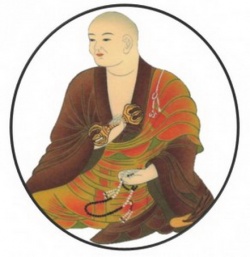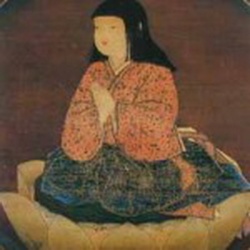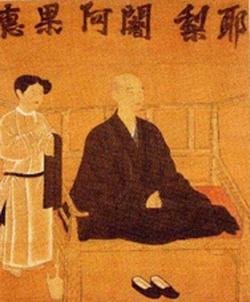Kobo Daishi
The founder of Shingon Buddhism in Japan, Kukai (空海), was a major figure in the early history of Japan and is considered by many as a cultural hero for his many innovations in language, calligraphy, knowledge of ancient texts, public education, and engineering. In and outside Shingon Buddhism, he is posthumously referred to as Kobo Daishi (弘法大師); the “great master of the propagation of the Buddhadharma”, or in short, ‘O-daishisama‘ (お大師様) or ‘O-daishisan‘ (お大師さん).
EARLY LIFE
Kukai was born into the aristocratic Saeki-Otomo clan in the late Nara period, 774, on the islands of Shikoku. His early life saw the shadows of social and political unrest in Japan at the time.
Very little is known about his childhood, though it is documented that in his formative years, Kukai displayed exemplary interest in the study of the Chinese classics as well as the Chinese language, from the time he was under the care of his uncle to the time he entered the aristocratic state funded college at the age of 18.
No sooner had he enrolled, he began reading and taking interest in the teachings of Buddhism. Disillusioned by the suffering occurring outside of his own noble caste, he left the college and resolved to become a Buddhist novice. Kukai began spending days in solitary retreat in the mountains, engaging in meditation, travelling, as well as strict ascetic practice. At a time when Buddhism was heavily controlled by the state, Kukai was warmly welcomed by other temples he wandered to, where he stayed to mainly to rest or study the scriptures. During his travels, one such spiritual exercise Kukai engaged in most frequently was the esoteric practice of reciting the mantra of Akasagarbha Bodhisattva.
Kukai received a revelation one night in which a voice spoke to him, revealing to him the location of the Mahavairocana Sutra. Though quite a profound scripture in sight, Kukai understood that the teaching would require meeting and learning from a qualified teacher with an orthodox lineage of Esoteric Buddhism, which at the time Japan did not have such teachers who could fully explain this to him. With this in mind, Kukai resolved to set sail to China.
______________________________
ARRIVAL IN CHINA AND MEETING MASTER HUIGUO
It took several years before Kukai could secure permission from the imperial court for him to travel outside Japan. In 804, Kukai along with a group of official delegates traveled on an expedition to China. Another famous monk, Saicho, the founder of the Tendai School, was among the members in the delegation. Braving torrential storms, Kukai’s ship arrived in Fujian Province within weeks. Originally met with suspicion, it was Kukai’s fluency in Chinese language that helped grant the delegation safe harbor and a warm welcome from the impressed Chinese government officials.
It had been a half a year since Kukai arrived in China, learning Sanskrit language and Indian Buddhism before he met the master Huiguo at Qinglong Temple, the seventh patriarch of Esoteric Buddhism in China. Huiguo had already been a renowned and well-sought monk with disciples numbering nearly 1,000. Huiguo however, believed that in order for the lineage to survive, it would have to be transmitted to a foreigner with a strong belief in teaching and benefiting sentient beings. On top of this, Huiguo was not given much time to live to transmit the full teaching to a disciple.
Huiguo took Kukai as his personal disciple and trained him in basic Esoteric Buddhist ritual and doctrine. Within a span of three months, Kukai received abhiseka (empowerment) from master Huiguo and became the Eighth Patriarch of Esoteric Buddhism, thus acknowledging that Kukai had attained Buddhahood in this life, in name and in reality. He received the lineage name “Bianzhao Jingang” (遍照金剛), known in Japanese as “Henjo Kongo”, the universally shining vajra. Soon afterward as predicted, master Huiguo died at 60. With Kukai’s mission completed in a very short span of time, he returned to Japan at the age of 33.
______________________________
INITIAL DIFFICULTY AND RISE TO FAME
Kukai would not achieve public fame upon returning home from China until three reigns later; the Emperor Kammu who had granted Kukai permission to enter China had already favored the monk Saicho and had given him imperial edicts to establish a school on behalf of the state; Kammu would later die of illness. The Emperor Heizei exhibited no real interest in Buddhism and had since abdicated and retired because of illness. Finally, the young Emperor Saga, who exhibited and recognized the talents of Kukai, appointed him as the administrative head of Todai-ji in Nara, one of the authoritative temples in Japan at the time. With this acknowledgement from the state as an authoritative leader in Buddhism, Kukai set about in founding the Shingon school (真言宗), the “true word school”.
Emperor Saga also accepted Kukai’s request to form the mountain wilderness retreat of Mount Koya (高野山) in today’s Wakayama Prefecture. Kukai envisioned Mount Koya to be a place that would be open for practitioners looking to seek the way and a proper place for Kukai and future generations after him to train future disciples in the way of Shingon Buddhism.
During the times of his rise, he would give teachings and conduct rituals for the government and for the populace at large, furthering his reputation in the imperial kingdom. Within years, Kukai had been appointed to several offices and had been given opportunities to build his base by assisting in construction work by building an artificial lake, as well as founding Japan’s first known public education school, which taught Buddhism as well as Confucianism and Taoism, believing that a proper education was a privilege for anyone, regardless of class.
______________________________
ENTERING ETERNAL SAMADHI AND LEGACY
Kukai, exhausted from his effort in laying a foundation for his school for posterity and for all beings, as well as his ardent dedication in helping humanity in spiritual and non-sectarian issues, spent his last years on Mount Koya away from the calls of the state. The ill Kukai spent his time in deep meditation, barely eating, before entering stillness on Mount Koya at the age of 62.
It is believed that because of Kukai’s exceptional faith in Esoteric Buddhist teaching, his body was said to have remained incorrupt and it is maintained this way at his tomb in Mount Koya. It is believed that Kukai had not physically died, but was in a eternal state of meditation, awaiting the arrival of Maitreya Bodhisattva in billions of kalpas to come.
Kukai had said that before his death, he admonished to those who followed him:
“When the sky no longer exists, when all living being have reached enlightenment, and when Nirvana is expended, only then shall my vow be completed.”
86 years after Kukai passed away, the legacy and faith in Kukai remained very strong, enough for the emperor Daigo to receive a vision from Kukai, believing this as a sign that Kukai was still alive on Mount Koya because of his eternal vow to help others in suffering. The emperor issued a decree that Kukai would be styled “Kobo Daishi” (弘法大師); the “great master of the propagation of the Buddhadharma”. At the same time, the Gohogo (御宝号), the sacred name of Kobo Daishi, was chanted and has been recited by those who have strong faith in Kobo Daishi,
南無大師遍照金剛 Namu Daishi Henjo Kongo
Homage to the Great Master, the Brilliantly Shining Vajra


